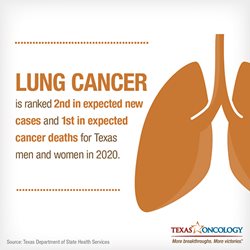 Lung cancer develops in the tissues of the lung, usually in the cells lining air passages. It is responsible for the most cancer-related deaths in both men and women in Texas. The most common type, non-small cell lung cancer, accounts for approximately 80-85% of lung cancers. Lung cancer can be treated and is often preventable, but only 21% of men and 30% of women live more than five years beyond their initial diagnosis.
Lung cancer develops in the tissues of the lung, usually in the cells lining air passages. It is responsible for the most cancer-related deaths in both men and women in Texas. The most common type, non-small cell lung cancer, accounts for approximately 80-85% of lung cancers. Lung cancer can be treated and is often preventable, but only 21% of men and 30% of women live more than five years beyond their initial diagnosis.
Statistics
- In 2024, an estimated 234,580 people will be diagnosed with lung cancer, and 125,070 deaths are expected in the U.S.
- Lung cancer is the deadliest cancer in both Texas and the United States, and claims more lives each year than colon, breast, and prostate cancers combined.
- In 2024 in Texas, an estimated 14,430 new lung cancer cases and 8,050 deaths are expected from the disease.
- About 80-90% of all lung cancer deaths are attributed to smoking, and smoking accounts for roughly 30% of all cancer deaths in the United States.
- Men and women who smoke are around 25 times more likely to develop lung cancer.
- About 10-20% of Americans that die of lung cancer each year have never smoked.
Risk Factors
- Smoking and Secondhand Smoke: Tobacco smoke is the most important risk factor for lung cancer, as it is thought to cause most lung cancer deaths. Secondhand smoke can cause lung cancer in nonsmokers. The more a person is exposed to smoke, the greater their risk of developing lung cancer.
- Age: Most people diagnosed with lung cancer are 65 or older.
- Family and/or Personal History: People with a parent or sibling who had lung cancer may have a higher-than-average risk, even if they are nonsmokers. Lung cancer survivors are at increased risk of secondary primary cancers.
- Carcinogen Exposure: People who live or work in certain conditions where they are exposed to radioactive gas, asbestos, arsenic, radon, diesel exhaust, air pollution, and other substances have an increased risk of developing lung cancer.
Symptoms
Lung cancer symptoms vary with each patient. People with any of these symptoms should consult their physician:
- Chest pain made worse with deep breathing, coughing, or laughing
- Coughing up blood, phlegm, or a persistent cough
- Hoarseness
- Loss of appetite
- Fatigue or weakness
- Wheezing
- Breathing trouble, such as shortness of breath
- Frequent or persistent lung infections, such as pneumonia or bronchitis
- Unintentional weight loss
Prevention and Screening
- Do not smoke. Smoking is the number one risk factor for lung cancer and can shorten life expectancy by 10 years.
- Avoid secondhand smoke. More than 7,300 people in the U.S. die annually from lung cancer as a result of exposure to secondhand smoke.
- Take precautions at work. Exposure to certain types of fumes, dust, and chemicals can cause lung cancer.
- Test your home for radon. Radon exposure varies by geographic region. Most of Texas has low levels of radon and does not require mitigation. If there are concerns, the following may be helpful: Radon is a radioactive gas that cannot be seen, felt, or tasted. Some homes are built on soil with natural occurring deposits, like uranium, which can create high levels of radon that can seep into the home. Long-term radon exposure increases your risk for lung cancer. Radon detection kits, as well as EPA-certified, can be used to test your home for radon.
- Get screened. People ages 50 to 80 who have smoked, on average, a pack of cigarettes daily for 20 years, whether they still smoke or have quit, are at a higher risk for lung cancer and should consider an annual low-dose CT to screen for lung cancer.
Treatment Options
Lung cancer, depending on the stage, may be treated by a team of specialists, including pulmonologists, thoracic surgeons, medical oncologists, and radiation oncologists. Treatment options vary depending on the stage and type of the cancer, the patient’s symptoms and overall health, and a variety of other factors. Lung cancer found at an early stage may be curable with surgery alone or with chemotherapy after surgery, and a small number of lung cancer cases that have spread to nearby organs can be cured with chemotherapy and radiotherapy. Targeted therapies may be beneficial in lung cancers with certain gene mutations, which can be identified by molecular testing. Immunotherapy, which reduces a tumor’s resistance to the body’s immune system, has become an important addition to standard treatments. Radiation therapy, proton therapy, and palliative medicine are other treatment modalities. Clinical trials evaluating new therapies for lung cancer may be available to patients.
Sources: American Cancer Society, American Lung Association, Centers for Disease Control and Prevention, National Cancer Institute, U.S. Environmental Protection Agency, and U.S. Preventive Services Task Force